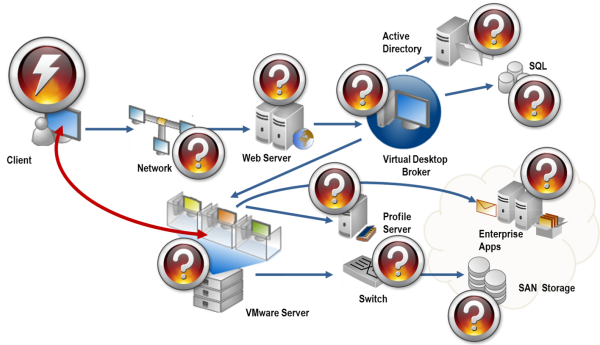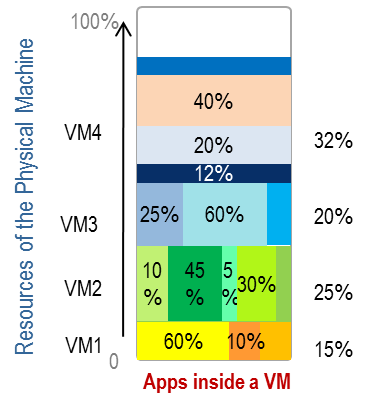Trying to manage physical Citrix environments and “seeing” what is going on inside the box has always been a bit challenging. Then the hypervisor showed up and suddenly the size, cost and consumption of physical servers no longer made sense and Citrix went virtual.
Flash forward to today and we have 2U (3.5” tall) servers with Citrix XenServer or VMware hypervisors installed, managing 10 to 15 XenApp server VMs, with 30 to 40 end users connected to each.
Achieving densities of 300-450 people per dual processor server is fantastic in every way except one. The difficulty managing the environment has literally increased 10x as we are no longer talking about 40 people connecting per server, but 400.
Citrix servers were never easy to see inside of and now behind the additional shroud the hypervisor presents, complexity and full visibility are even more difficult.

Adding the hypervisor layer to Citrix just adds one more variable in the application delivery model.
So what is the best way to manage the new complexities the hypervisor brings to the table?
Optimally, you want a tool that can see the “outside” view of each VM on a host server, as well as being able to see ‘inside” each virtual machine and how the applications inside of the virtual machine are performing.
 The Outside view of the virtual machine shows the portion of physical resources used by each VM (CPU, disk, memory) This information is provided by the hypervisor management console. This is perfect for capacity planning and identifying issues related to CPU consumption, disk utilization and memory availability. What the hypervisor management tool will not provide you with (today) is an explanation of WHY a VM is consuming the resources it is consuming.
The Outside view of the virtual machine shows the portion of physical resources used by each VM (CPU, disk, memory) This information is provided by the hypervisor management console. This is perfect for capacity planning and identifying issues related to CPU consumption, disk utilization and memory availability. What the hypervisor management tool will not provide you with (today) is an explanation of WHY a VM is consuming the resources it is consuming.
 The Inside view of the virtual machine is much more difficult information to collect with the management tools in place, for the most part, today. If you have a tool with access to this inside view, you can see the portion of resources allocated to each VM that are used by each application and each user of the VM.
The Inside view of the virtual machine is much more difficult information to collect with the management tools in place, for the most part, today. If you have a tool with access to this inside view, you can see the portion of resources allocated to each VM that are used by each application and each user of the VM.
In a Microsoft Windows environment, this information is provided by WMI. This is useful for identifying guest OS issues, misbehaving applications (yeah, that never happens), unauthorized user activities and user load balancing among other things.
Management tools that provide visibility inside a virtual machine should tell you why a virtual machine is consuming what it is consuming.
There is not a lot out there right now that will give you visibility all the way down to the applications running on a virtual machine.
What to Look for in Citrix Management Tools
- Find a management tool that will let you see all of these potential suspects in one pane of glass. There are approximatly 11 different services that can impact the performance of Citrix (Active Directory, SQL, hypervior, virtual machine OS, etc.)
- When evaluating Citrix management tools, pay particular attention to how the management tools manage the hypervisor and its interaction with Citrix. Most of the tools out there today do not get this granular, but this is the exact visibility you are going to want when things begin to unravel.
- Particularly with Citrix, look for tools that place a strong emphasis on managing and monitoring the end user experience. "End User Experience" is a buzzword today so don't just check the box if the tool claims to have end user management. Ask for specifics and you will see the solutions can vary wildly.
- Strong capacity planning guidance. One of the questions I hear most often is "How many users can we get on a Citrix server?" The truth is none of us know exactly how your particular stack of applications is going to perform on your servers, over your network, in your environment.
We all can make educated guesses based on past experience, but none of us can tell you for certain without using a capacity planning tool. Citrix offers one such tool, but there are some great ones baked into tools that are great at managing Citrix that can compliment the reporting functionality of EdgeSight.
The right tool with the right capacity planning functionality can help you right size your environment and save thousands of dollars on hardware.
One large healthcare customer I know of saved $400,000 of what they had budgeted for server hardware because the capacity planning tool baked into their managment tool showed them where their calculations were wrong.
The less your team knows about Citrix the better your managment tools need to be. Look for tools that incorporate the four items listed above and you will be off to a great start.
Good luck on your journey to see inside Citrix.






Leave Comment